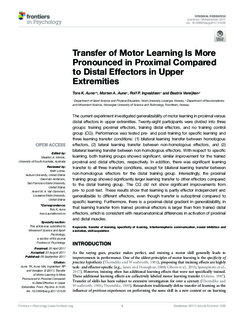| dc.contributor.author | Aune, Tore Kristian | |
| dc.contributor.author | Aune, Morten Andreas | |
| dc.contributor.author | Ingvaldsen, Rolf P. | |
| dc.contributor.author | Vereijken, Beatrix | |
| dc.date.accessioned | 2017-10-04T06:44:19Z | |
| dc.date.available | 2017-10-04T06:44:19Z | |
| dc.date.created | 2017-09-08T12:54:23Z | |
| dc.date.issued | 2017 | |
| dc.identifier.citation | Frontiers in Psychology. 2017, 8 . | nb_NO |
| dc.identifier.issn | 1664-1078 | |
| dc.identifier.uri | http://hdl.handle.net/11250/2458190 | |
| dc.description.abstract | The current experiment investigated generalizability of motor learning in proximal versus distal effectors in upper extremities. Twenty-eight participants were divided into three groups: training proximal effectors, training distal effectors, and no training control group (CG). Performance was tested pre- and post-training for specific learning and three learning transfer conditions: (1) bilateral learning transfer between homologous effectors, (2) lateral learning transfer between non-homologous effectors, and (3) bilateral learning transfer between non-homologous effectors. With respect to specific learning, both training groups showed significant, similar improvement for the trained proximal and distal effectors, respectively. In addition, there was significant learning transfer to all three transfer conditions, except for bilateral learning transfer between non-homologous effectors for the distal training group. Interestingly, the proximal training group showed significantly larger learning transfer to other effectors compared to the distal training group. The CG did not show significant improvements from pre- to post-test. These results show that learning is partly effector independent and generalizable to different effectors, even though transfer is suboptimal compared to specific learning. Furthermore, there is a proximal-distal gradient in generalizability, in that learning transfer from trained proximal effectors is larger than from trained distal effectors, which is consistent with neuroanatomical differences in activation of proximal and distal muscles. | nb_NO |
| dc.language.iso | eng | nb_NO |
| dc.publisher | Frontiers Media | nb_NO |
| dc.rights | Navngivelse 4.0 Internasjonal | * |
| dc.rights.uri | http://creativecommons.org/licenses/by/4.0/deed.no | * |
| dc.title | Transfer of Motor Learning Is More Pronounced in Proximal Compared to Distal Effectors in Upper Extremities | nb_NO |
| dc.type | Journal article | nb_NO |
| dc.type | Peer reviewed | nb_NO |
| dc.description.version | publishedVersion | nb_NO |
| dc.source.pagenumber | 11 | nb_NO |
| dc.source.volume | 8 | nb_NO |
| dc.source.journal | Frontiers in Psychology | nb_NO |
| dc.identifier.doi | 10.3389/fpsyg.2017.01530 | |
| dc.identifier.cristin | 1492101 | |
| dc.description.localcode | © 2017 The Authors. Published by Frontiers Media. This is an open access article under the CC BY license (http://creativecommons.org/licenses/by/4.0/) | nb_NO |
| cristin.unitcode | 194,65,1,0 | |
| cristin.unitcode | 194,65,30,0 | |
| cristin.unitname | MH fakultetsadministrasjon | |
| cristin.unitname | Institutt for nevromedisin og bevegelsesvitenskap | |
| cristin.ispublished | true | |
| cristin.fulltext | original | |
| cristin.qualitycode | 2 | |

